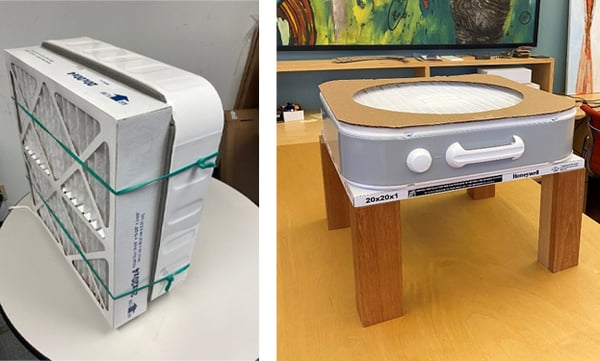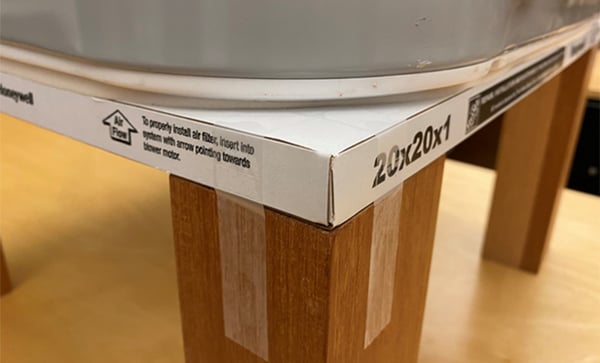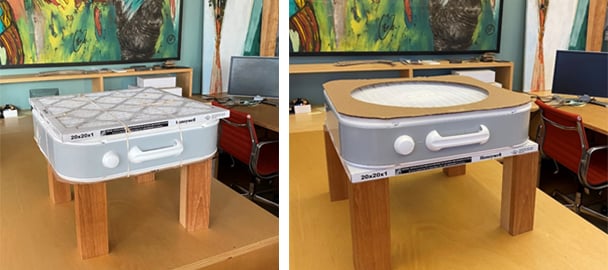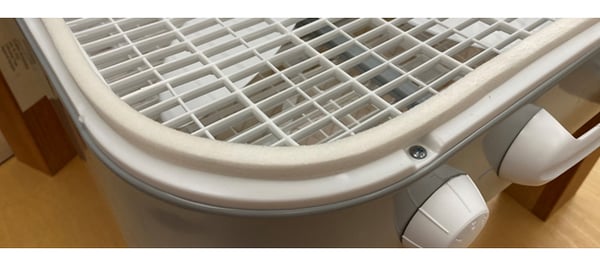If you don’t have the funds or means to get a portable air cleaner (some are on backorder), there is a do-it-yourself solution that is easy and inexpensive.[i] This box fan solution has been tested to filter out up to 90% of particulates.[ii] This DIY solution has actually been used for years for air pollution reduction, and very often in woodshops. Be aware however, that this will produce more noise than a standard air cleaner.
We at Pirie Associates tried this solution in our office by combining many of the recommendations from various DIY instructions[iii] [iv] and came up with our own mash-up solution. If you like this idea and want to give it a try, we have the following recommendations:

Left Image: DIY box fan by Jim Rosenthal of Tex-air Filters, Right Image: Pirie Associates’ DIY box fan mash-up
- Filter Selection
Use a 20x20 MERV13 filter (the Home Depot equivalent is FPR 10). A 4” filter yields better airflow than a 1” filter, but we haven’t been able to find a 4” filter in stock at our local hardware stores.
- Filter Orientation
Make sure the filter is oriented in the direction of air flow. There is an arrow on the side of the filter that indicates air flow direction.
- Box Fan Mounting and Orientation
In a larger room with multiple people, it is a good idea to prop the fan well up off the floor and on supports to blow upwards at the breathing zone elevation so it is not directly blowing across people. Place the fan in the middle of the room.[v] Note that the fan does vibrate and depending on the supports you use, it might work its way off of the supports over time. We noticed that on the 2nd speed setting, the wood legs we used took about an hour and a half to dislodge themselves from underneath the fan.

Image showing legs working their way out from beneath the filter.
We solved that by scotch taping the filter to the legs, and in our brief test, placing weatherstripping between the fan and the filter provides enough friction to hold the fan securely atop the filter.

Close-up Image showing scotch tape holding legs in place underneath filter. Notice air flow direction on filter.
- Airflow
Something we at Pirie noticed when implementing this solution is that the box fan wants to move a lot of air and adding the filter to one side causes the fan to draw additional air from the non-filter side, especially in the corners. We created and installed a cardboard shield on the opposite side of the fan to block the corners. In our unscientific testing (by feeling the air on the outside of the filter) this shield increased the airflow through the filter. If you can find one, the increased surface area of a 4” filter would increase airflow further. Alternatively, a prominent aerosol scientist, Richard Corsi, recommends making a box out of 5 filters (see image below) which will significantly increase the airflow and the lifespan of the filter and motor.[vi] However, this will also increase the cost of the solution. Another potential solution might be to use 4 filters as a stand for the fan.

Left image: Pirie’s cardboard shield, Right Image: Filter “Corsi box fan filter” as tested by Jim Rosenthal.
- Filter Placement

Left image: Exhaust Side, Right Image: Intake Side. The fan is blowing upward in both images.
-
-
- Intake Side
-
Pro: Placement of the filter is generally recommended on the intake side.
Con: The dirty side of the filter is exposed to touch and touching the dirty side of the filter can resuspend viral particles.
-
-
- Exhaust Side
-
Pro: If the filter is placed on the exhaust side, the dirty side of the filter is protected from touch by the fan.
Con: The turbulent air within the fan can resuspend viral particles within the box fan. Having it on the exhaust side also taxes the motor more.
- Securing the Filter to Box Fan
We do not recommend taping the filter to the box fan because it makes it harder to replace the filter when needed. Remove the feet from the fan to prevent obstruction since they will not be used. Using rubber bands to attach the filter seems to work fine (see above exhaust side image). We tied a few rubber bands together to make one larger one. If you want to add more of an air seal, you can use self-adhering weatherstripping on the fan perimeter. In fact, if the filter is on the intake side, no rubber bands are needed, the filter is sandwiched between the supports and the fan, and the cardboard shield is held on by suction at the corners.

Image: Optional weatherstripping detail
- Filter Replacement
Remember to write the installation date on the filter so you know when it should be replaced. Typically, the filter should be replaced every 1-3 months depending on the level of indoor contamination. If the filter gets noticeably dirty, that’s a good indication that it should be replaced. Be careful when you replace the filter that you don’t shake particles lose.
- Don’t Leave the Fan-Filter Running while Unattended.
It can be a fire hazard if the motor gets too hot. Having the fan on lower settings can reduce noise and lower the risk associated with the motor overheating.
Hopefully, the time we spent testing out the practicality of this solution for our space can help others make their spaces safer.
As with all recommendations, we urge you to use common sense to make sure the conditions in your environment – and with your DIY box fan - are safe for people and places!
Please share your DIY box fan filter installations by emailing images to us – we’ll share out your solutions in a future blog!
[i] Could a Janky, Jury-Rigged Air Purifier Help Fight Covid-19?
[ii] Build a do-it-yourself air purifier for about $25
[iii] How a MERV 13 Air Filter and a Box Fan Can Help Fight Covid-19
[iv] DIY Box Fan Plus Filter Demonstration
[v] Helping Kids Protect Themselves From Dirty Air, One DIY Filter at a Time
[vi] A Variation on the “Box Fan with MERV 13 Filter” Air Cleaner




